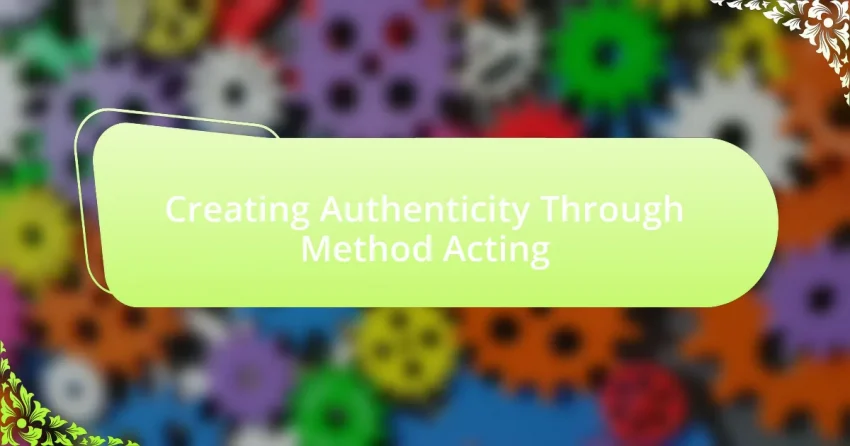Method acting is an acting technique that emphasizes emotional authenticity by encouraging actors to draw on their personal experiences and emotions to create believable performances. Originating from the work of Konstantin Stanislavski and popularized by Lee Strasberg, this approach has evolved to include foundational principles such as emotional memory, sense memory, and improvisation. Key figures like Strasberg, Stella Adler, and Sanford Meisner have shaped its development, leading to a focus on internal motivation and psychological realism in acting. While method acting enhances character depth and audience engagement, it also presents challenges, including emotional strain and the risk of mental health issues, necessitating effective management strategies for actors.

What is Method Acting and How Does It Create Authenticity?
Method acting is an acting technique that encourages actors to draw on their own emotions and experiences to create a more authentic performance. This approach, developed by Lee Strasberg and influenced by Konstantin Stanislavski, emphasizes emotional truth and psychological realism, allowing actors to fully inhabit their characters. By immersing themselves in the character’s emotional state and background, actors can produce performances that resonate deeply with audiences, as evidenced by the success of method actors like Marlon Brando and Robert De Niro, who are known for their intense and believable portrayals. This technique fosters authenticity by blurring the lines between the actor’s personal experiences and the character’s narrative, resulting in a compelling and relatable performance.
How did Method Acting originate and evolve over time?
Method Acting originated in the early 20th century, primarily through the work of Konstantin Stanislavski, who developed a system focused on emotional authenticity and psychological realism in performance. This approach evolved as it was adopted and adapted by various acting schools and practitioners, notably Lee Strasberg, who introduced it to American theater in the 1930s, emphasizing the use of personal experiences to inform character portrayal. Over time, Method Acting became a dominant technique in the United States, influencing actors and directors in film and theater, and leading to a greater emphasis on internal motivation and emotional truth in performances.
Who were the key figures in the development of Method Acting?
The key figures in the development of Method Acting include Lee Strasberg, Stella Adler, and Sanford Meisner. Lee Strasberg, often referred to as the father of Method Acting, was instrumental in popularizing the technique through his teachings at the Actors Studio, where he emphasized emotional memory and personal experience. Stella Adler, a prominent actress and teacher, contributed to Method Acting by integrating the importance of imagination and character analysis, diverging from Strasberg’s focus on emotional recall. Sanford Meisner, another influential figure, developed the Meisner Technique, which emphasized instinctual responses and the importance of listening and reacting in the moment. These three individuals significantly shaped the principles and practices of Method Acting, making it a foundational approach in American theater and film.
What are the foundational principles of Method Acting?
The foundational principles of Method Acting include emotional memory, sense memory, and the use of improvisation. Emotional memory involves actors drawing on their own past experiences to evoke genuine emotions in their performances. Sense memory focuses on recalling physical sensations to enhance the authenticity of the character’s experience. Improvisation allows actors to explore their characters in real-time, fostering spontaneity and deeper connection to the role. These principles, developed by Lee Strasberg and influenced by Stanislavski’s system, aim to create a more truthful and immersive performance by encouraging actors to fully inhabit their characters.
What distinguishes Method Acting from other acting techniques?
Method Acting is distinguished from other acting techniques by its emphasis on emotional authenticity and personal experience. This technique encourages actors to draw from their own emotions and memories to create a deeper connection with their characters, often leading to more genuine performances. Unlike traditional acting methods that may focus on external techniques or physicality, Method Acting requires actors to immerse themselves fully in their roles, often employing techniques such as sense memory and emotional recall. This approach was popularized by Lee Strasberg and is rooted in the teachings of Konstantin Stanislavski, who believed that an actor’s personal experiences could enhance the portrayal of a character.
How does emotional memory play a role in Method Acting?
Emotional memory is central to Method Acting as it enables actors to draw upon their personal experiences to create authentic performances. This technique, developed by Lee Strasberg, encourages actors to recall and relive their own emotional experiences, allowing them to connect deeply with their characters. Research indicates that this approach enhances emotional truthfulness in performances, as actors can evoke genuine feelings that resonate with the audience. Strasberg’s methods emphasize the importance of personal emotional recall, which has been shown to improve the depth and realism of character portrayals in theatrical and cinematic contexts.
What techniques are unique to Method Acting?
Method Acting employs techniques such as emotional memory, sense memory, and improvisation to create authentic performances. Emotional memory involves actors recalling personal experiences to evoke genuine emotions relevant to their character, enhancing the depth of their portrayal. Sense memory requires actors to tap into their physical sensations and memories to bring realism to their performances. Improvisation allows actors to react spontaneously, fostering a natural flow in dialogue and interactions. These techniques are rooted in the teachings of Lee Strasberg, who emphasized the importance of personal experience in acting, making Method Acting distinct in its approach to authenticity.
Why is authenticity important in acting?
Authenticity is crucial in acting because it enables actors to create believable and relatable characters that resonate with audiences. When actors portray emotions and experiences truthfully, they foster a genuine connection with viewers, enhancing the overall impact of the performance. Research indicates that audiences are more engaged and emotionally affected by performances that exhibit authenticity, as demonstrated in studies on audience perception and emotional response. For instance, a study published in the Journal of Personality and Social Psychology found that viewers are more likely to empathize with characters who display authentic emotions, leading to a deeper understanding of the narrative. Thus, authenticity not only enriches the actor’s portrayal but also significantly influences audience engagement and emotional investment in the story.
How does Method Acting enhance an actor’s performance?
Method Acting enhances an actor’s performance by allowing them to deeply connect with their character’s emotions and experiences. This technique encourages actors to draw from their own personal memories and feelings, creating a more authentic portrayal. Research indicates that actors who employ Method Acting often deliver performances that resonate more profoundly with audiences, as they embody their roles with genuine emotional depth. For instance, a study published in the Journal of Theatre and Performance found that Method actors were perceived as more believable and relatable compared to those using traditional acting techniques. This connection to personal experience not only enriches the performance but also fosters a stronger emotional response from viewers, ultimately elevating the overall impact of the work.
What impact does authenticity have on audience perception?
Authenticity significantly enhances audience perception by fostering trust and emotional connection. When performers exhibit genuine emotions and relatable experiences, audiences are more likely to engage deeply with the narrative. Research indicates that audiences respond positively to authentic portrayals, as seen in a study published in the Journal of Communication, which found that viewers rated performances higher when they perceived the actors as authentic. This connection not only increases viewer satisfaction but also encourages repeat engagement with the content.

What are the Practical Applications of Method Acting?
The practical applications of method acting include enhancing emotional authenticity, improving character immersion, and fostering a deeper connection between the actor and the role. Method acting techniques, such as emotional recall and sense memory, allow actors to draw from personal experiences to evoke genuine emotions, resulting in more believable performances. Research indicates that actors who employ method acting often achieve higher levels of audience engagement and critical acclaim, as seen in the performances of actors like Marlon Brando and Daniel Day-Lewis, who are known for their intense preparation and commitment to their roles. This approach not only benefits theatrical performances but also extends to film and television, where authenticity is crucial for storytelling.
How can actors effectively implement Method Acting techniques?
Actors can effectively implement Method Acting techniques by immersing themselves in their characters’ emotional experiences and backgrounds. This involves extensive research into the character’s life, motivations, and circumstances, allowing actors to draw from personal experiences to create authentic portrayals. Techniques such as emotional memory, where actors recall their own past emotions to connect with their character’s feelings, and sense memory, which involves recalling physical sensations, are crucial. Additionally, practicing improvisation can help actors stay in character and react naturally in various situations. These methods have been validated by numerous successful actors, including Marlon Brando and Robert De Niro, who have credited Method Acting for their ability to deliver powerful performances.
What exercises can actors use to develop emotional memory?
Actors can use various exercises to develop emotional memory, including sense memory exercises, emotional recall techniques, and improvisational activities. Sense memory exercises involve recalling specific sensory experiences, such as smells or sounds, to evoke emotions tied to those memories. Emotional recall techniques require actors to access personal memories that elicit strong feelings, allowing them to connect authentically with their characters. Improvisational activities encourage spontaneity and emotional exploration, helping actors to react genuinely in the moment. These methods are grounded in the principles of method acting, which emphasize the importance of personal experience in creating believable performances.
How can actors create a character’s backstory using Method Acting?
Actors can create a character’s backstory using Method Acting by immersing themselves in the character’s experiences and emotions. This technique involves extensive research into the character’s life, including their upbringing, relationships, and significant life events, allowing actors to draw from personal experiences that resonate with the character’s journey. For instance, actors may use techniques such as sensory memory and emotional recall to connect deeply with the character’s past, enhancing authenticity in their performance. Method Acting emphasizes the importance of understanding the psychological and emotional motivations behind a character’s actions, which can be supported by the work of Lee Strasberg, a key figure in Method Acting, who advocated for the exploration of personal memories to inform character portrayal.
What challenges do actors face when using Method Acting?
Actors face several challenges when using Method Acting, primarily emotional strain, difficulty in separating from their characters, and the risk of mental health issues. Emotional strain occurs as actors immerse themselves deeply into their roles, often reliving traumatic experiences to evoke genuine emotions, which can lead to psychological distress. The difficulty in separating from characters arises because Method Acting encourages actors to draw from their personal experiences, making it hard to disengage from the emotional state of the character after performances. Additionally, the risk of mental health issues is significant, as prolonged immersion in intense emotional states can lead to anxiety, depression, or other psychological problems. These challenges highlight the demanding nature of Method Acting and its potential impact on an actor’s well-being.
How can actors manage emotional strain during performances?
Actors can manage emotional strain during performances by employing techniques such as emotional regulation, mindfulness, and physical grounding. Emotional regulation allows actors to control their emotional responses, preventing overwhelming feelings from affecting their performance. Mindfulness practices, such as deep breathing and meditation, help actors stay present and focused, reducing anxiety and emotional fatigue. Physical grounding techniques, like using specific body movements or props, can anchor actors in their roles, providing a sense of stability amidst emotional turbulence. Research indicates that these strategies can enhance performance quality while safeguarding mental health, as evidenced by studies showing that mindfulness can reduce stress and improve emotional resilience in high-pressure situations.
What are common misconceptions about Method Acting?
Common misconceptions about Method Acting include the belief that it requires actors to experience real emotional pain or trauma to portray a character authentically. This is inaccurate; Method Acting emphasizes emotional recall and imagination rather than actual suffering. Another misconception is that Method actors are always “in character,” which is not true; they can switch between their personal selves and their roles as needed. Additionally, some think that Method Acting is only about emotional performance, overlooking its techniques that also involve physicality and sensory experiences. These misconceptions can lead to misunderstandings about the training and application of Method Acting in performance.

What are the Benefits and Limitations of Method Acting?
Method acting offers the benefit of deep emotional connection and authenticity in performances, allowing actors to fully immerse themselves in their characters. This technique encourages actors to draw from their personal experiences, which can lead to more genuine portrayals, as evidenced by acclaimed performances from method actors like Marlon Brando and Daniel Day-Lewis, who have received numerous awards for their immersive roles.
However, method acting also has limitations, including the potential for emotional distress and difficulty in separating from the character after a performance. Actors may experience psychological challenges, as seen in cases where individuals struggle with mental health issues due to the intense emotional demands of the method. Additionally, the approach can be time-consuming and may not suit all acting styles or productions, limiting its applicability in various contexts.
What advantages does Method Acting offer to performers?
Method Acting offers performers the advantage of deep emotional connection to their characters, enhancing authenticity in their portrayals. This technique encourages actors to draw from their personal experiences and emotions, allowing for a more genuine representation of the character’s feelings and motivations. Research indicates that Method Acting can lead to improved audience engagement, as viewers often resonate more with performances that convey real emotional depth. Additionally, Method Acting fosters a strong sense of character immersion, which can result in more memorable and impactful performances.
How does Method Acting contribute to character depth?
Method Acting contributes to character depth by encouraging actors to draw from their own emotional experiences to create authentic portrayals. This technique allows performers to fully immerse themselves in their characters, leading to a more nuanced and believable representation. For instance, actors like Marlon Brando and Daniel Day-Lewis have utilized Method Acting to explore complex emotional landscapes, resulting in performances that resonate deeply with audiences. Research indicates that this approach enhances emotional connection and realism, as actors embody their characters’ psychological states, thereby enriching the narrative and engaging viewers on a profound level.
In what ways can Method Acting improve an actor’s skills?
Method Acting can significantly enhance an actor’s skills by fostering deep emotional connection and authenticity in performances. This technique encourages actors to draw from their own experiences and emotions, allowing them to portray characters with greater realism and depth. Research indicates that actors who engage in Method Acting often demonstrate improved emotional range and character immersion, leading to more compelling performances. For instance, a study published in the Journal of Theatre and Performance found that actors trained in Method Acting exhibited higher levels of empathy and emotional intelligence, which are crucial for effective character portrayal.
What limitations should actors be aware of when using Method Acting?
Actors should be aware that Method Acting can lead to emotional exhaustion and difficulty separating personal identity from character. This technique often requires deep emotional immersion, which can result in psychological strain and potential mental health issues if not managed properly. Additionally, the intense focus on personal experiences may limit an actor’s ability to portray characters outside their own emotional range, potentially hindering versatility. Historical examples, such as the experiences of actors like Heath Ledger and Marilyn Monroe, illustrate the risks of emotional entanglement with roles, emphasizing the need for actors to maintain boundaries for their well-being.
How can Method Acting lead to emotional exhaustion?
Method Acting can lead to emotional exhaustion because it requires actors to deeply immerse themselves in their characters’ emotions and experiences, often blurring the lines between their own feelings and those of the character. This intense emotional engagement can result in psychological fatigue, as actors may struggle to detach from the emotional states they embody during performances and rehearsals. Research indicates that prolonged exposure to such emotional intensity can lead to symptoms similar to burnout, including chronic fatigue and emotional depletion, as seen in studies on the psychological effects of role immersion in acting.
What are the risks of becoming too immersed in a character?
Becoming too immersed in a character poses several psychological risks, including emotional distress, identity confusion, and difficulty in disengaging from the role. Actors who deeply embody their characters may experience heightened anxiety or depression, as they may struggle to separate their own emotions from those of the character. Research indicates that method acting can lead to a phenomenon known as “role engulfment,” where individuals lose sight of their personal identity, leading to potential mental health issues. A study published in the Journal of Personality and Social Psychology highlights that prolonged immersion in a character can result in significant emotional turmoil, as actors may internalize the character’s experiences and traumas.
What are some best practices for creating authenticity through Method Acting?
To create authenticity through Method Acting, actors should immerse themselves in their characters’ experiences and emotions. This involves extensive research into the character’s background, motivations, and circumstances, allowing the actor to connect deeply with the role. Techniques such as emotional recall, where actors draw upon their own memories to evoke genuine feelings, enhance this authenticity. Additionally, practicing improvisation can help actors respond naturally in character, further solidifying their portrayal. Studies in performance psychology indicate that such immersive techniques can lead to more believable performances, as they align the actor’s emotional state with that of their character.
